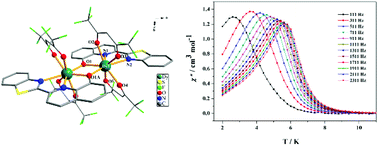Luminescence, magnetocaloric effect and single-molecule magnet behavior in lanthanide complexes based on a tridentate ligand derived from 8-hydroxyquinoline†
Abstract
A new family of lanthanide complexes, [Ln2(hfac)4L2] (Ln = Eu (1), Gd (2), Tb (3), Dy (4), Ho (5), Er (6), Lu (7); hfac = hexafluoroacetylacetonate, HL = 2-(2′-benzothiazole)-8-hydroxyquinoline), was synthesized and characterized using single-crystal X-ray diffraction, elemental analysis (EA), thermal gravimetric analysis (TGA), powder X-ray diffraction (PXRD) and UV-vis spectra. X-ray crystallographic analyses reveal that 1–7 are isomorphous and crystallize in the monoclinic space group C2/c. In these dinuclear complexes, each LnШ ion is eight-coordinated with two bidentate hfac and two μ-phenol bridging L ligands. The TGA results show that the complexes have relatively high thermal stabilities. Complexes 1 and 3 show the characteristic transitions of the corresponding lanthanide ions with ligand-related emission peaks. Meanwhile, complexes 4 and 7 exhibit ligand-centered fluorescence at room temperature. Magnetic measurements were carried out on complexes 2–6. The magnetic study reveals that 2 displays a magnetocaloric effect, with a maximum −ΔSm value of 16.89 J K−1 kg−1 at 2 K for ΔH = 8 T. Dynamic magnetic studies reveal single-molecule magnet (SMM) behavior for complex 4. Fitting the dynamic magnetic data to the Arrhenius law gives an energy barrier ΔE/kB = 50.33 K and pre-exponential factor τ0 = 1.05 × 10−8 s.


 Please wait while we load your content...
Please wait while we load your content...